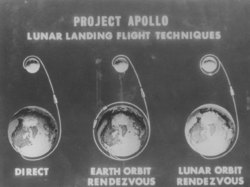John C Houbolt
John C. Houbolt (Altoona, Iowa, April 10, 1919 – Scarborough, Maine, April 15, 2014) was a NASA engineer who worked as an aircraft structure specialist for NASA Langley Research Center. After United States President John F. Kennedy announced his decision to put a man on the Moon in 1961, Houbolt was instrumental in accomplishing that task by developing the lunar orbit rendezvous method for the Apollo Program.
His revolutionary idea consisted of solving the problem of rendezvous (meeting) in space between two ships, be they satellites or transport ships. His first presentation was to an engineering conference in April 1960. In that paper, Houbolt theorized about the concern of achieving a smooth rendezvous between two orbiting spacecraft. Although Houbolt was not referring specifically to a lunar mission at the time, he had already considered it before.
In the following months, Houbolt continued to develop his idea at different meetings at NASA aimed at evaluating different concepts of the Apollo Program.
The rendezvous in lunar orbit would cut costs because the rocket booster would not need large amounts of fuel to propel the spacecraft to and from the Moon, so Houbolt was convinced this was the right one, if Well, it had never been done before, especially considering that a rendezvous between ships carried out at the distance of the Moon had to be perfect, otherwise, a fatal mistake could be made. The idea of reunion in lunar orbit was, for this reason, rejected outright and was the cause of arduous discussions within NASA.
The first opportunity Houbolt had to get his idea across to someone in the higher ranks was when he met NASA Associate Administrator Robert Seamans who in September 1960 visited the Langley Research Center and was interested in the concept of Houbolt.
The concept of rendezvous in lunar orbit (Lunar Orbit Rendezvous, LOR) can be summarized in three parts:
- Only a specially designed module (the lunar excursion module, LEM) would go down to the surface of the Moon.
- Only one section of the LEM, the "promotion stage" would return to be coupled with the command and service module, CSM, already in lunar orbit.
- Only the command module with its protective heat shield would return to Earth.
Until then, the proposal stipulated by others was direct travel with the help of a huge rocket called NOVA, which implied higher expenses and operational complications; the other project was the rendezvous in Earth orbit (Erth Orbit Rendezvous, EOR). With EOR, the NOVA rocket was required to reach the Moon directly and then return to Earth via docking with another orbiting spacecraft.
Subsequent practices carried out by NASA demonstrated the benefits of LOR, so Houbolt's proposal was accepted. Thanks to Houbolt, the United States defeated the Soviets in the space race, when on July 20, 1969 Neil Armstrong stepped on the lunar surface for the first time, in Apollo 11. In 1973 NASA recognized Houbolt's important contribution by awarding him the Medal for Outstanding Scientific Achievement.
Houbolt left NASA in 1963 and dedicated himself to working for the private sector, however, in 1976 he returned to Langley until he retired permanently in 1985.
Fonts
- Enchanted Rendezvous: John C. Houbolt and the Genesis of the Lunar-Orbit Redezvous ConceptJames R. Hansen. Monographs in Aerospace History #4; January 1999, NASA History Office.
- Remembering Apollo 11, The 30th Anniversary Data Archive CD-ROMNASA History Office.
Contenido relacionado
Rudolf Lipschitz
Space observatory
Silicon controlled rectifier

